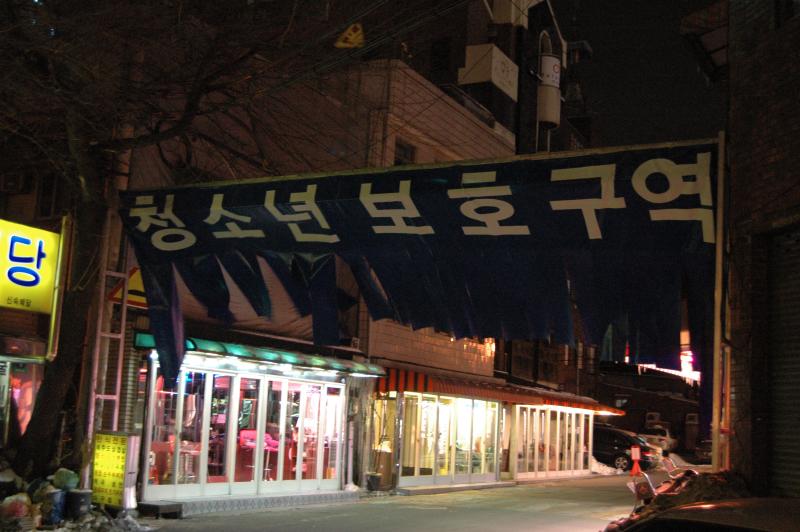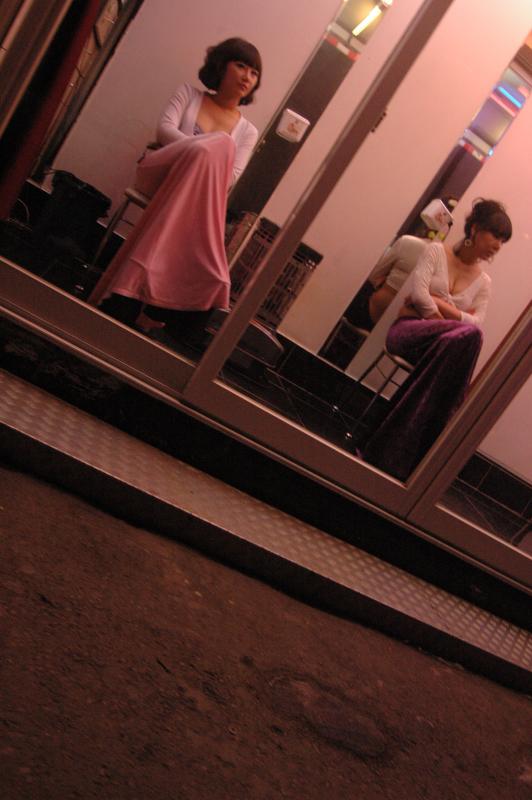As a travel blogger, I make it an effort to see a wide variety of places - both on the touristy side of things as well as off the beaten path. Today is a special day of sorts - it's been two years to the day since I arrived in Korea. From the beginning, I started covering places to see in Seoul and Korea (I started blogging in late 2007, although I didn't arrive in Korea until later) - during that time I've discovered quite a few places you definitely won't see on any tourist maps.
Of the five, the first one is probably the best known among expats in Korea: Hooker Hill / Homo Hill.
Don't let the two names fool you - we're talking about two areas, within a stone's throw of each other, in the same neighborhood. The history of Hooker Hill wouldn't be complete without including Itaewon and the Yongsan Garrison - although the official histories leave out a lot of the story. After Yongsan Garrison opened in the 1970's, the area became a central place for businesses catering to the foreign soldiers. The prostitution business was one causing significant problems in the area until 2004, when the USFK began trying to clean up the area. Trying is the key word - to this day, the area still offers a number of women selling themselves under one cover or another. You're far more likely to be 'juicy bars', 'kissing rooms' and 'da bang' than out-and-out prostitution.
Yongsan red-light district

Of the five, the first one is probably the best known among expats in Korea: Hooker Hill / Homo Hill.
Don't let the two names fool you - we're talking about two areas, within a stone's throw of each other, in the same neighborhood. The history of Hooker Hill wouldn't be complete without including Itaewon and the Yongsan Garrison - although the official histories leave out a lot of the story. After Yongsan Garrison opened in the 1970's, the area became a central place for businesses catering to the foreign soldiers. The prostitution business was one causing significant problems in the area until 2004, when the USFK began trying to clean up the area. Trying is the key word - to this day, the area still offers a number of women selling themselves under one cover or another. You're far more likely to be 'juicy bars', 'kissing rooms' and 'da bang' than out-and-out prostitution.
Yongsan red-light district

청소년 보호 구역 - the text translates to 'Youth Reserves' or 'Youth Protection District' according to Google Translate (better translations are always welcome!), but the point is to warn passers-by of a red-light district. As is fairly usual, the glass walls allow for a view - but you'll have to get closer to ask for prices. Don't bother, though - half the time they don't, er, service foreigners, and the other half of the time they'll quote you an outrageous price.

The reasons why may be self-explanatory, but the pictures are proof.
Moran Meat Market
I've blogged about this place before - while you'll see some directions to the older but respectable 'five-day' market, you won't see anything about the area where dogs and other animals are sold for consumption. It's right across the parking lot, and is easy enough to spot if you're in the area. If you're in the market to eat some dog, there are plenty of dog-meat restaurants around to satisfy your taste buds.
For some strange reason, however, eating dogs doesn't quite resonate with the average Western tourist. Think what you like, but don't try to change it by going in PETA style or trying to buy a dog to set them free.
The Gupo Market in Busan is similar in nature - find that by taking line 3 of the Busan subway to Deokcheon station. Take exit 3 to street level, turn right at the first street then left at the first street.
The Gupo Market in Busan is similar in nature - find that by taking line 3 of the Busan subway to Deokcheon station. Take exit 3 to street level, turn right at the first street then left at the first street.
Yeongdeungpo / Cheongnyangni
Two more red-light districts still clinging to life. Before thinking that flashing those green (or gold) bills will somehow open doors to sexy women, understand that foreigners are generally shooed away. Those that aren't might be caught by the police (and while the bribes might be offered by the Koreans caught for the same thing, you won't get that opportunity) Walk by, look around if you like, and move on.
Any bosintang (boshintang) restaurant
In case the Moran Meat Market wasn't enough for you, most bosintang (보신탕) restaurants still have an old-fashioned feel to them. The few that weren't put out of business before the 1988 Summer Olympics are still hanging on in the older non-renovated parts of the city. Expect them to be busiest during malbok, the last of Korea's three summer 'dog days'. It's when the heat will make you want for stamina. For those traveling with a queasy stomach, other foods are available; don't be too surprised if a dog's leg is offered your way by another patron. If looking to avoid eating Fido, pass on gaejangguk (dog meat soup) gaesuyuk (boiled dog meat), gaesoju (a drink with dog meat and herbal ingredients), and gaegogi (literally, dog meat) as well.
Readers - any favorite Korean spots that you won't find in any tourist brochures? Comments are open!
 © Chris Backe - 2010
© Chris Backe - 2010This post was originally published on my blog, Chris in South Korea. If you are reading this on another website and there is no linkback or credit given, you are reading an UNAUTHORIZED FEED.



 RSS Feed
RSS Feed
Recent comments